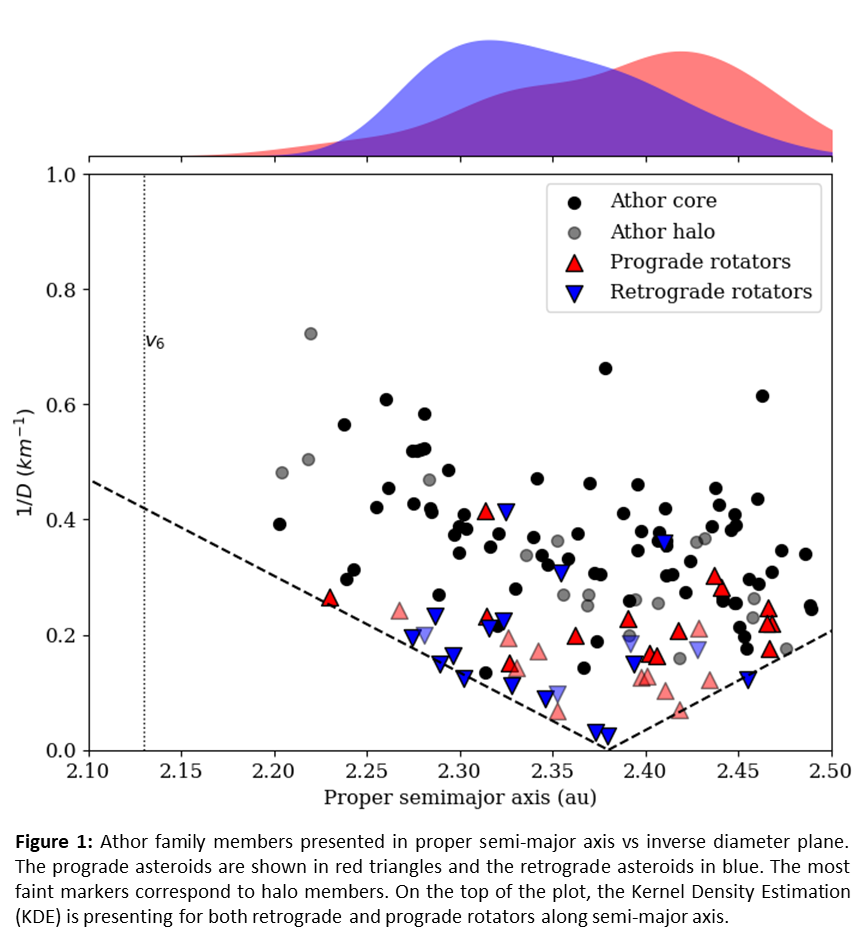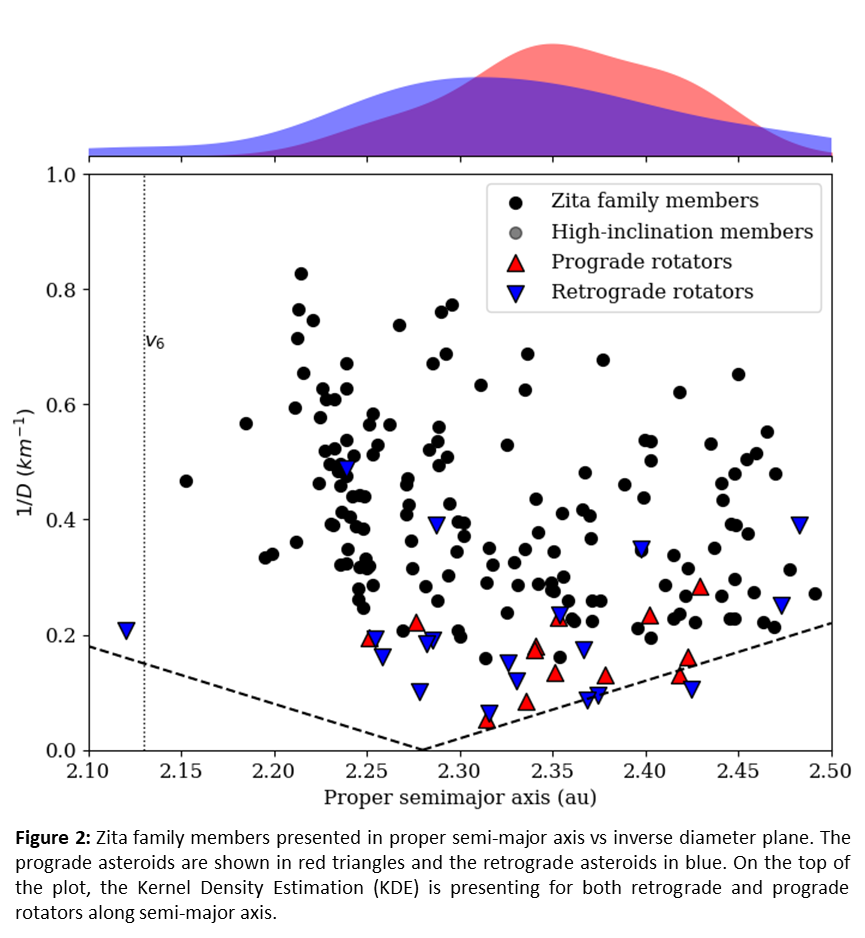Spin states of X-complex asteroids in the Inner Main Belt confirm the existence of Athor and Zita collisional families.
- 1Section of Astrophysics, Astronomy and Mechanics, Department of Physics, National and Kapodistrian University of Athens, Athens, Greece (dimathanaso@phys.uoa.gr)
- 2Institute for Astronomy, Astrophysics, Space Applications and Remote Sensing, National Observatory of Athens, Athens, Greece
- 3Faculty of Mathematics and Physics, Institute of Astronomy, Charles University, Prague, Czech Republic
- 4School of Physics and Astronomy, University of Leicester, Leicester, United Kingdom
- 5Lowell Observatory, Flagstaff, Arizona, USA
- 6Bigmuskie Observatory (B88), Asti, Italy
- 7BSA Osservatorio (K76), Cuneo, Italy
- 8Laboratoire Lagrange, Centre National de la Recherche Scientifique, Observatoire de la Côte d’Azur, Université Côte d’Azur, Nice, France
- 9Institute of Physics, Faculty of Natural Sciences and Mathematics, Ss. Cyril and Methodius University, Skopje, Republic of North Macedonia
- 10Belgrade Astronomical Observatory, Belgrade, Serbia
- 11Department of Astronomy, Faculty of Mathematics, University of Belgrade, Belgrade, Serbia
- 12Main Astronomical Observatory of NAS of Ukraine, Kyiv, Ukraine
Introduction:
Numerous energetic collisions between asteroids in the inner Solar System have led to the creation of groups of fragments, known as asteroid collisional families. These families populate the Main Belt, each family typically originating from a single parent body that was shattered [1]. The fragments of the same collision form a characteristic V-shape in the plane defined by inverse diameter (1/D) and orbital semimajor axis (a), due to the Yarkovsky effect [2, 3]. It is a thermal force, which cause outward drift to prograde rotating asteroids and inward drift to retrograde. A method for the identification of very old and dispersed asteroid families has been developed [4,5] to search for families by their V-shapes. Such families may be invisible with the Hierarchical Clustering Method (HCM) [6, 7]. So far, six asteroid families have been discovered by using the V-shape method: the Eulalia and New Polana families [8], a low-albedo primordial family [5] with nominal age of about 4 Gyr, Athor family, ~3.0 Gyr-old, Zita family, ~4.5 Gyr-old [9] and an S-complex asteroid family, ~4.3 Gyr-old [10].
Here, we study the spin states of asteroids that belong to the two X-complex asteroid families in the Inner Main Belt, Athor and Zita [9, 11]. Athor family is detectable also with HCM, conversely, the Zita family is not, as its members have dispersed in orbital elements (ghost family, according to [12]).
Methodology:
We used shape models that were retrieved from the literature or databases as well as multi-epoch observational datasets. Dense-in-time photometric data were retrieved from the literature and obtained from “Ancient Asteroids”1, our own observing campaign [13]. Specifically, we obtained 366 new lightcurves for 84 asteroids. Sparse-in-time photometric data were retrieved from sky surveys, namely: ASAS-SN, ATLAS, PTF, ZTF, and space missions, Gaia and TESS. Further data were collected from published asteroid models.
We reduced and calibrated the photometric data following the same methodology of previous works [14, 15, 16] and using different weights for each dataset based on their accuracy [17]. Then we applied the Convex Inversion (CI) method, developed by Kaasalainen et al. [18, 19], for each asteroid from our sample. The CI reveals the spin axis orientation of asteroids, hence their sense of rotation.
Results:
Athor family:
We obtained 31 new asteroid models for Athor family and 9 revised ones. Including the archival models, the spin state is known for 49 members.
Figure 1 shows the spin states of Athor family members distributed in the family's V-shape. We found that the outward side of the family exhibits a statistical predominance of prograde asteroids of 76% and in the inward side retrograde asteroids of 60%. Considering only the family core, the outward side presents similar excess of prograde asteroids (77%) and inward side excess of retrograde asteroids (72%). The Kernel Density Estimation (KDE) visualizes qualitatively the underlying probability distribution for the retrograde and prograde rotators and presents two clear peaks: one for retrograde rotators in the inward side and another for prograde in the outward side.

Zita family:
Concerning the Zita family, we produced 17 new asteroid models and 7 revised. Including the archival models, the spin state is known for 32 members.
Figure 2 shows the spin states of Zita family members distributed in the family's V-shape. We found that the 80% the Zita members in the inward side are retrograde rotators, while the outward side contains same number of prograde and retrograde asteroids. The KDE presents a clear peak for prograde in the outward side, while the maximum for retrograde rotators is around family’s V-shape center.

Conclusions:
The Athor family exhibits a statistical predominance of retrograde asteroids in the inward side and, conversely, predominance of prograde asteroids in the outward side. This result adds evidence that the members are fragments of the same parent body, an EL planetesimal, that was shattered about 3 Gy ago.
The Zita family demonstrates an excess of retrograde asteroids in the inward side, but there is absence of asteroids due to orbital resonances. Conversely, the outward side does not present any predominance with an equal distribution of prograde and retrograde rotators. However, KDE exhibits a clear peak for prograde asteroids in the outward side.
The spin states of these asteroids, derived from observations and modeling, validate the existence of the Athor and Zita families, with the Athor family exhibiting a stronger signature, which is expected as it is younger and more compact. This research provides independent confirmation and characterisation of these very old families, offering tight constraints for our Solar System's evolution models [10, 20].
References:
[1] Zappalà et al. (1984). Icarus, 59(2), 261-285.
[2] Bottke et al. (2006). Annu. Rev. Earth Planet. Sci., 34, 157-191.
[3] Vokrouhlický et al. (2006). Icarus, 182(1), 118-142.
[4] Bolin et al. (2017). Icarus, 282, 290-312.
[5] Delbo et al. (2017). Science, 357(6355), 1026-1029.
[6] Zappalà et al. (1990). Astron.J., 100, 2030-2046.
[7] Zappalà et al. (1995). Icarus, 116(2), 291-314.
[8] Walsh et al. (2013). Icarus, 225(1), 283-297.
[9] Delbo et al. (2019). A&A, 624, A69.
[10] Ferrone et al. (2023). A&A, 676, A5.
[11] Avdellidou et al. (2022). A&A, 665, L9.
[12] Dermott et al. (2021). MNRS, 505(2), 1917-1939.
[13] Athanasopoulos et al. (2021). EPSC2021-355.
[14] Hanuš et al. (2011) A&A, 530, A134.
[15] Hanuš et al. (2013). A&A, 551, A67.
[16] Athanasopoulos et al. (2022). A&A, 666, A116.
[17] Hanuš et al. (2023). A&A, 679, A56.
[18] Kaasalainen et al. (2001). Icarus, 153(1), 24-36.
[19] Kaasalainen et al. (2001). Icarus, 153(1), 37-51.
[20] Avdellidou et al. (2024). Science, eadg8092.
Acknowledgments:
D.A. acknowledges support from the Academy Complex Systems of the Universite Côte d’Azur under the scheme “Programme de visites doctorales". M.D. and C.A. acknowledge support from ANR “ORIGINS” (ANR-18- 647 CE31-0014). The Czech Science Foundation has supported the research of J.H. through grant 22-17783S. N.T. acknowledge support from the Astronomical station Vidojevica and funding from the Ministry of Science, Technological Development and Innovation of the Republic of Serbia (451-03-47/2023-01/ 200002) and by the European Commission through project BELISSIMA (call FP7-REGPOT-2010-5, No. 256772).
1http://users.uoa.gr/~kgaze/ancient_asteroids.html
How to cite: Athanasopoulos, D., Hanuš, J., Avdellidou, C., van Belle, G., Ferrero, A., Bonamico, R., Gazeas, K., Delbo, M., Rivet, J.-P., Apostolovska, G., Todorović, N., Novakovic, B., Vchkova Bebekovska, E., and Romanyuk, Y.: Spin states of X-complex asteroids in the Inner Main Belt confirm the existence of Athor and Zita collisional families., Europlanet Science Congress 2024, Berlin, Germany, 8–13 Sep 2024, EPSC2024-359, https://doi.org/10.5194/epsc2024-359, 2024.